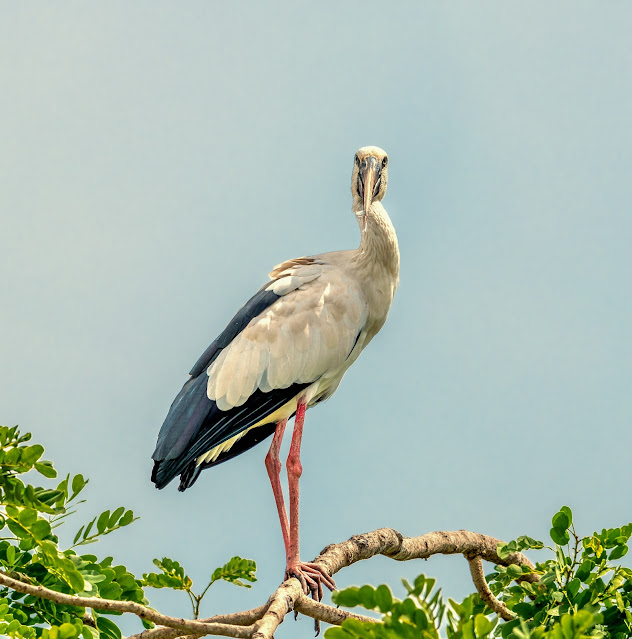Asian Openbill Bird (Anastomus oscitant)
Introduction:
The Asian Openbill Bird, also known as the Asian Openbill Stork or simply Openbill, is a unique species of bird belonging to the stork family (Ciconiidae). It is distinguished by its specialized bill, which has a distinct gap or "open" space near the tip. These birds are widely distributed across South and Southeast Asia and are known for their striking appearance and fascinating feeding habits.
Physical Characteristics
Size: The Asian Openbill Bird is a medium-sized stork, measuring around 60 to 68 centimeters (24 to 27 inches) in length.
Plumage: The bird's plumage is predominantly black and white. The body is covered in black feathers, while the wings, tail, and neck are primarily white.
Distinctive Bill: The most noticeable feature of the Asian Openbill is its bill, which is pale grey with a gap or notch between the mandibles near the tip. This unique adaptation allows them to feed on their preferred diet.
Legs: They have long, sturdy legs that aid in wading through shallow water, where they often find their food.
Habitat:
The Asian Openbill Bird inhabits a variety of wetland habitats, including freshwater marshes, swamps, ponds, paddy fields, and other shallow water bodies. They are commonly found in lowland areas and coastal regions.
Feeding Behavior
The name "Openbill" is derived from the bird's feeding behavior. The specialized bill of the Asian Openbill allows it to exploit a particular food source: primarily snails, clams, and other mollusks. They use their bill to probe into mud and water, accessing their prey from their shells with remarkable precision. This dietary adaptation sets them apart from other storks that mainly feed on fish or amphibians.
Social Behavior
Asian Openbill Birds are usually seen in flocks, often foraging together in wetland areas. They are generally non-migratory birds, staying in their chosen habitats throughout the year. During the breeding season, they may form nesting colonies, building large stick nests on trees.
Breeding and Conservation
These storks breed during the monsoon season when their preferred wetland habitats are abundant with food. They lay two to four eggs in their nests, and both parents take part in incubating the eggs and caring for the chicks.
As for conservation, the Asian Openbill Bird is currently listed as a species of "Least Concern" by the International Union for Conservation of Nature (IUCN). However, like many wetland-dependent species, they are vulnerable to habitat loss and degradation due to human activities, and efforts are underway to protect and preserve their natural habitats.
Asian Openbill Bird History
The Asian Openbill Bird (Anastomus oscitans) has a fascinating history intertwined with its unique characteristics and its ecological significance in the wetland ecosystems of South and Southeast Asia.
Evolution and Classification
As a member of the stork family (Ciconiidae), the Asian Openbill has evolved over millions of years to adapt to its specific feeding behavior and habitat preferences. Storks, in general, are large, long-legged birds known for their graceful appearance and ability to wade in shallow water while foraging for food.
Taxonomic Discovery
The Asian Openbill Bird was first described scientifically by the British ornithologist Thomas Horsfield in 1821. Horsfield was a naturalist and physician who made significant contributions to the field of zoology during his time in Southeast Asia. He collected and studied specimens from the region, including the Asian Openbill, and classified them according to their distinct features and characteristics.
Feeding Behavior and Adaptations
The unique and defining feature of the Asian Openbill is its specialized bill, which has a gap or notch near the tip. This adaptation allows the bird to feed primarily on snails, clams, and other mollusks, which are abundant in the wetland habitats it inhabits. By inserting its bill into the shells, the Openbill can extract the soft parts of the mollusks with remarkable precision.
Cultural Significance
Throughout history, storks, including the Asian Openbill, have been a subject of admiration and fascination in various cultures. In some regions, they are considered symbols of luck, prosperity, and fertility. Folklore and traditional stories often depict storks as messengers of good news or as guardians of children.
Ecological Importance
The Asian Openbill plays a vital role in wetland ecosystems by regulating the population of mollusks and other invertebrates. Their feeding behavior helps control snail populations, which can otherwise become pests in rice paddies and other wetland areas. Additionally, the bird's presence in wetlands indicates the overall health of these ecosystems, making them valuable indicators of environmental well-being.
Conservation Concerns
While the Asian Openbill Bird is currently classified as a species of "Least Concern" by the IUCN, its conservation status may be influenced by factors such as habitat loss, pollution, and disturbance of wetland areas. Human activities, such as urbanization and agricultural expansion, have led to the destruction and degradation of wetland habitats, potentially impacting the bird's populations in the future.
As the understanding of the Asian Openbill Bird's history and ecological importance continues to grow, conservation efforts are increasingly focused on safeguarding its natural habitats and ensuring the long-term survival of this unique and captivating species.








0 comments:
Post a Comment